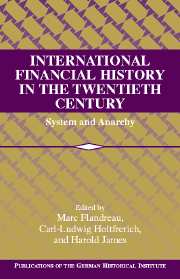Book contents
- Frontmatter
- Introduction
- 1 Caveat Emptor: Coping with Sovereign Risk Under the International Gold Standard, 1871-1913
- 2 Conduits for Long-Term Foreign Investment in the Gold Standard Era
- 3 The Gold-Exchange Standard: A Reinterpretation
- 4 The Bank of France and the Gold Standard, 1914-1928
- 5 Keynes’s Road to Bretton Woods: An Essay in Interpretation
- 6 Bretton Woods and the European Neutrals, 1944-1973
- 7 The 1948 Monetary Reform in Western Germany
- 8 The Burden of Power: Military Aspects of International Financial Relations During the Long 1950s
- 9 Denationalizing Money?: Economic Liberalism and the “National Question” in Currency Affairs
- 10 International Financial Institutions and National Economic Governance: Aspects of the New Adjustment Agenda in Historical Perspective
- Index
3 - The Gold-Exchange Standard: A Reinterpretation
Published online by Cambridge University Press: 05 January 2013
- Frontmatter
- Introduction
- 1 Caveat Emptor: Coping with Sovereign Risk Under the International Gold Standard, 1871-1913
- 2 Conduits for Long-Term Foreign Investment in the Gold Standard Era
- 3 The Gold-Exchange Standard: A Reinterpretation
- 4 The Bank of France and the Gold Standard, 1914-1928
- 5 Keynes’s Road to Bretton Woods: An Essay in Interpretation
- 6 Bretton Woods and the European Neutrals, 1944-1973
- 7 The 1948 Monetary Reform in Western Germany
- 8 The Burden of Power: Military Aspects of International Financial Relations During the Long 1950s
- 9 Denationalizing Money?: Economic Liberalism and the “National Question” in Currency Affairs
- 10 International Financial Institutions and National Economic Governance: Aspects of the New Adjustment Agenda in Historical Perspective
- Index
Summary
The gold-exchange standard of the 1920s, at least among economists, has suffered an infamous posterity. “There are few Englishmen who do not rejoice at the breaking of our gold fetters,” Keynes declared when Britain elected to abandon the system in 1931. In the current era, when monetary authorities have institutionalized flexible exchange rates with a modicum of success, most analysts looking backward tend to agree. The attempt to reconstitute the status quo ante by reestablishing the gold standard after World War I proved “a dreadful mistake,” opines Peter Temin. Barry Eichengreen insists that only when the monetary authorities repudiated the principles of “orthodox finance” could recovery from the Great Depression begin. Allan Meltzer sees no compelling evidence that a gold-standard regime offers superior price stability to compensate for the easier transmission of shocks or the potential variability in output and employment.
The classic older treatment by Charles Kindleberger does not fully echo those criticisms. Kindleberger concedes that monetary adjustment mechanisms did not work properly in the Depression, but he faults a cumulation of policy failures as much as insurmountable structural problems. Still, Kindleberger views the monetary regime of the 1920s as fatally impaired by the absence of a hegemon. Great Britain no longer possessed the financial clout to clear the market of distress goods, lend counter-cyclically, or discount in a crisis. The United States did not yet acknowledge a responsibility proportionate to its economic means to serve as the global stabilizer. Although Kindleberger differs in emphasis from his Keynesian successors, he, too, regards the gold-exchange standard regime as inadequate in practice to the challenges of post–World War I reconstruction.
- Type
- Chapter
- Information
- International Financial History in the Twentieth CenturySystem and Anarchy, pp. 77 - 94Publisher: Cambridge University PressPrint publication year: 2003
- 1
- Cited by



